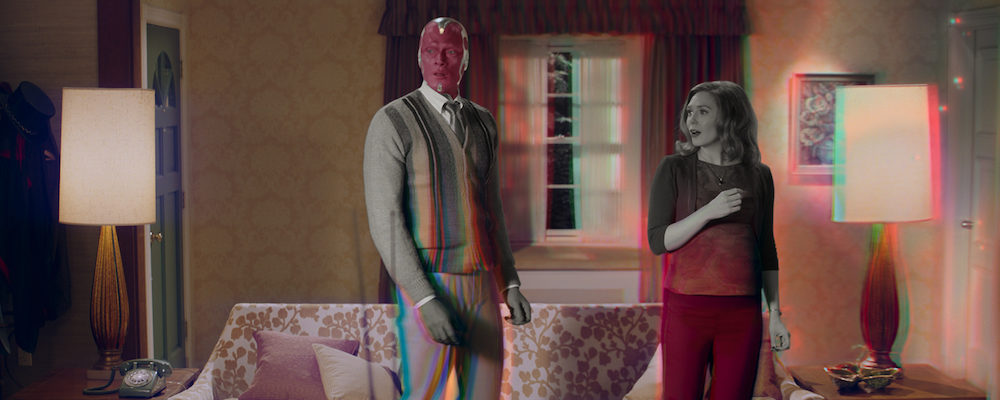Marvel’s ‘WandaVision’ Travels a Cryptic Journey Through TV History
Alci Rengifo
Marvel’s “WandaVision” opens like some strange dream where comic book personas mix with classic TV history. It’s a unique offering where devoted fans of the MCU can obsessively search for clues or hints to how it connects to every other Marvel movie that came before, while the non-member of the clan can drink in its beautifully wild aesthetic. Nostalgia has been the name of the game for a while now in many shows and films. “WandaVision” kicks it up a notch. The effect is deliciously disorienting. We feel like time travelers, while aware the whole “Avengers” saga in the present is ongoing.
The show is set in a TV suburbia named Westview. Wanda (Elizabeth Olsen) and Vision (Paul Bettany) are a pristine couple of newlyweds who move in and try desperately to fit into the local, ‘50s conservative community. Of course we already know they are really the Scarlet Witch and Vision, who were recently embroiled in the cosmic war against Thanos in the “Avengers” movies. How they end up in this reality is left for viewers to decipher. For now what we get are episodes intentionally winking at the very texture of classic TV sitcoms like “Bewitched” and “The Brady Bunch.” Their antics and dilemmas are delightful romps. In the pilot, Vision is desperate to impress his boss Mr. Hart (Fred Melamed) at the office, where his job consists of “computational services,” whatever that means. In another episode Wanda tries to fit in with the local housewives by partaking with Vision in a fundraising magic show (which goes south when Vision accidentally swallows chewing gum). Then it all switches to color for a ‘70s-themed episode where Wanda and Vision deal with the possibility of a pregnancy, powers going awry and Vision’s growing suspicions not all is right in this town.
Before getting into the intricacies and clues of “WandaVision,” it is first enjoyable as a curious pop experiment. This is a rather lush show visually, perfectly rendering homage to the styles of classic television with references to “I Dream of Jeannie” and naturally “I Love Lucy.” Like David Fincher’s recent movie “Mank,” this isn’t even nostalgia on the order of “Stranger Things” and “Mad Men,” instead it seeks to literally re-create the feeling that you’re watching a show in 1961. Episodes are shot in the old 4:3 aspect ratio that was the norm before widescreen televisions. The music, camera angles and dialogue never hint that these characters are aware they inhabit the 21st century. The humor is as innocent as what you have seen on a sitcom in 1972. What we already know about these Marvel characters is then seamlessly incorporated into it. While Vision distracts Mr. Hart and his wife (Debra Jo Rupp of “That ‘70s Show”), Wanda uses her powers to levitate the perfect dinner into place. Vision accidentally swallows gum while trying to hang out with the local neighborhood men and it wrecks his system, which never processes any kind of food. He’s the klutzy husband to Wanda’s more orderly wife. Bettany and Olsen’s chemistry is perfection, especially during a magic show sequence in the season’s second episode.
How this all connects to the wider Marvel Cinematic Universe is revealed in bits and clues. Followers of the MCU know Vision should be dead, after Thanos killed him to get the Mind Stone in “Infinity War.” Wanda or Scarlet Witch failed to bring him back when she herself was restored after death in the grand conclusion of “Endgame.” So how is it that they’re reunited? Like a Marvel version of “Twin Peaks,” the secrets seem to lie around the very nature of Westview. Vision senses the neighbors are a bit off. A neighbor that may seem like your usual, whacky friend like Agnes (Kathryn Hahn) hints at a more threatening reality by the third episode, while another friend, Monica (Teyonah Parris), blurts out a specific reference to “Age of Ultron.” There are also “ads” during “commercial breaks” in the episodes with ads for soaps and watches that suspiciously feature the logo and name of Hydra, the fascist underground organization featured across the MCU. The greatest clue comes at the end of each episode, when the end credits give a bigger visual hint as to what’s going on, and we begin to suspect the tragic dimensions of this alternate reality. There are moments of sly satire as well, as when Vision makes a joke about one of the neighborhood men being a Communist and everyone getting really tense, before bursting out into big laughs.
While the MCU gets referenced constantly as the main example of how movies are now dominated by loud, popcorn franchises and superheroes, their worth as pop art is less discussed. “WandaVision” is a puzzle that is also close in spirit to entries like “Thor: Ragnarok,” which boasted a score and tone taken out of ‘80s sci-fi B-movies, and “Guardians of the Galaxy,” where ‘60s palettes combined with a use of classic rock that is still being endlessly copied today. There’s something fun and bold about doing a whole Marvel show with the literal, breezy feel of “The Brady Bunch,” and then slowly hinting at the darker edges and possibilities. This can’t possibly be the current reality of these characters and that’s the point. Nostalgia functions like a dream and “WandaVision” is like a happy hallucination of classic television. We revisit these old shows and forget Vietnam and the Civil Rights struggle were raging out in the real world. Westview is picture-perfect, then one of the characters takes a leap or makes an observation, and it turns out the whole dream is a facade. We happily follow Wanda and Vision into their paradise but know sooner or later, they will have to change the dial back to reality.
“WandaVision” season one begins streaming Jan. 15 with new episodes premiering every Friday on Disney+.

